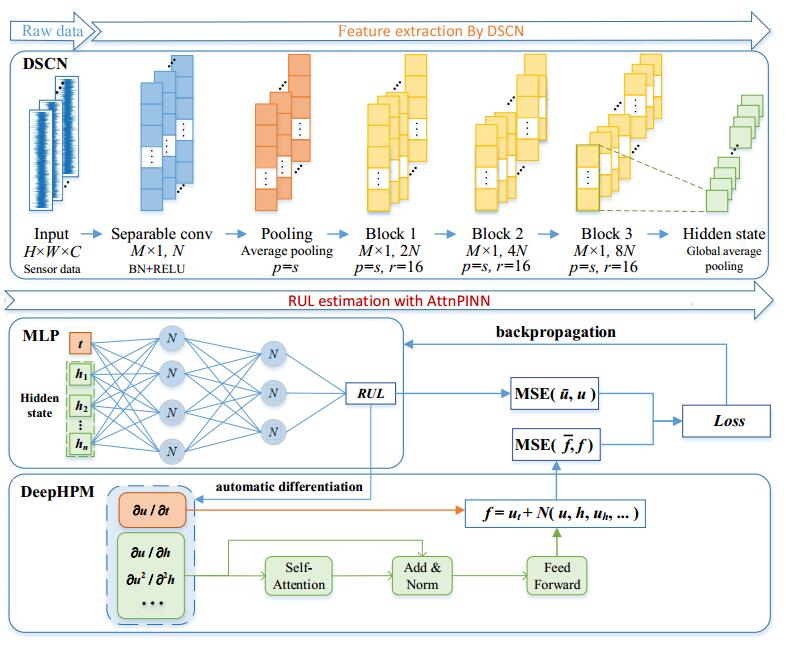|
[1]
|
. Rezaeianjouybari B, Shang Y. Deep learning for prognostics and health management: State of the art, challenges, and opportunities. Measurement 2020;163:107929.
|
|
[2]
|
. Wei J, Dong G, Chen Z. Remaining useful life prediction and state of health diagnosis for lithium-ion batteries using particle filter and support vector regression. IEEE Transactions on Industrial Electronics 2017;65(7):5634–5643.
|
|
[3]
|
. Cui L, Wang X, Wang H, et al. Research on remaining useful life prediction of rolling element bearings based on time-varying Kalman filter. IEEE Transactions on Instrumentation and Measurement 2019;69(6):2858–2867.
|
|
[4]
|
. Li X, Ding Q, Sun JQ. Remaining useful life estimation in prognostics using deep convolution neural networks. Reliability Engineering & System Safety 2018;172:1–11.
|
|
[5]
|
. Liao Y, Zhang L, Liu C. Uncertainty prediction of remaining useful life using long short-term memory network based on bootstrap method. In: IEEE International Conference on Prognostics and Health Management (ICPHM); 2018.
|
|
[6]
|
. Ren L, Sun Y, Cui J, et al. Bearing remaining useful life prediction based on deep autoencoder and deep neural networks. Journal of Manufacturing Systems 2018;48:71–77.
|
|
[7]
|
. Cao Y, Ding Y, Jia M, et al. A novel temporal convolutional network with residual selfattention mechanism for remaining useful life prediction of rolling bearings. Reliability Engineering & System Safety 2021;215:107813.
|
|
[8]
|
. Ding H, Yang L, Cheng Z, et al. A remaining useful life prediction method for bearing based on deep neural networks. Measurement 2021;172: 108878.
|
|
[9]
|
. Hinton GE, Osindero S, Teh YW. A fast learning algorithm for deep belief nets. Neural Computation 2006;18(7):1527–1554.
|
|
[10]
|
. Bengio Y, Simard P, Frasconi P. Learning longterm dependencies with gradient descent is difficult. IEEE Transactions on Neural Networks 1994;5(2):157–166.
|
|
[11]
|
. Loutas TH, Roulias D, Georgoulas G. Remaining useful life estimation in rolling bearings utilizing data-driven probabilistic Esupport vectors regression. IEEE Transactions on Reliability 2013; 62(4):821–832.
|
|
[12]
|
. Alfarizi MG, Tajiani B, Vatn J, et al. Optimized random forest model for remaining useful life prediction of experimental bearings. IEEE Transactions on Industrial Informatics 2023; 19(6): 7771–7779.
|
|
[13]
|
. Ali JB, Chebel-Morello B, Saidi L, et al. Accurate bearing remaining useful life prediction based on Weibull distribution and artificial neural network. Mechanical Systems and Signal Processing 2015;56–57:150–172.
|
|
[14]
|
. Vaswani A, Shazeer N, Parmar N, et al. Attention is all you need. In: 31st Conference on Neural Information Processing Systems; 2017.
|
|
[15]
|
. Liu L, Song X, Zhou Z. Aircraft engine remaining useful life estimation via a double attention-based data-driven architecture. Reliability Engineering & System Safety 2022;221:108330.
|
|
[16]
|
. Xu D, Xiao X, Liu J, et al. Spatio-temporal degradation modeling and remaining useful life prediction under multiple operating conditions based on attention mechanism and deep learning. Reliability Engineering & System Safety 2023;229: 108886.
|
|
[17]
|
. Li H, Cao P, Wang X, et al. Multi-task spatiotemporal augmented net for industry equipment remaining useful life prediction. Advanced Engineering Informatics 2023;55:101898.
|
|
[18]
|
. You KS, Qiu GQ and Gu YK. A 3D attentionenhanced hybrid neural network for turbofan engine remaining life prediction using CNN and BiLSTM models. IEEE Sensors Journal 2023; online, doi: 10.1109/JSEN.2023.3296670.
|
|
[19]
|
. Soleimani M, Campean F, Neagu D. Integration of Hidden Markov Modelling and Bayesian Network for fault detection and prediction of complex engineered systems. Reliability Engineering & System Safety 2021;215:107808.
|
|
[20]
|
. Karniadakis GE, Kevrekidis IG, Lu L, et al. Physics-informed machine learning. Nature Reviews Physics 2021;3(6):422–440.
|
|
[21]
|
. Karimian SF, Moradi R, Cofre-Martel S, et al. Neural network and particle filtering: a hybrid framework for crack propagation prediction. arXiv preprint 2020; arXiv:2004.13556.
|
|
[22]
|
. Xu Y, Kohtz S, Boakye J, et al. Physics-informed machine learning for reliability and systems safety applications: State of the art and challenges. Reliability Engineering & System Safety 2023; 230:108900.
|
|
[23]
|
. Raissi M, Perdikaris P, Karniadakis GE. Physicsinformed neural networks: A deep learning framework for solving forward and inverse problems involving nonlinear partial differential equations. Journal of Computational Physics 2019;378: 686–707.
|
|
[24]
|
. Cai S, Mao Z, Wang Z, et al. Physics-informed neural networks (PINNs) for fluid mechanics: A review. Acta Mechanica Sinica 2021;37(12): 1727–1738.
|
|
[25]
|
. Cofre-Martel S, Lopez Droguett E, Modarres M. Remaining useful life estimation through deep learning partial differential equation models: A framework for degradation dynamics interpretation using latent variables. Shock and Vibration 2021;2021:9937846.
|
|
[26]
|
. Raissi M. Deep hidden physics models: Deep learning of nonlinear partial differential equations. The Journal of Machine Learning Research 2018;19(1):932–955.
|
|
[27]
|
. Liao X, Chen S, Wen P, et al. Remaining useful life with self-attention assisted physics-informed neural network. Advanced Engineering Informatics 2023;58:102195.
|
|
[28]
|
. Wang B, Lei Y, Li N, et al. Deep separable convolutional network for remaining useful life prediction of machinery. Mechanical Systems and Signal Processing 2019;134:106330.
|
|
[29]
|
. Wang B, Lei Y, Li N, et al. A hybrid prognostics approach for estimating remaining useful life of rolling element bearings. IEEE Transactions on Reliability 2018;69(1):401–412.
|
|
[30]
|
. Ioffe S, Szegedy C. Batch normalization: Accelerating deep network training by reducing internal covariate shift. In: 32nd International Conference on Machine Learning; 2015. p. 448– 456.
|
|
[31]
|
. Nair V, Hinton GE. Rectified linear units improve restricted Boltzmann machines. In: 27th international conference on machine learning;2010. p. 807–814.
|
|
[32]
|
. Saxena A, Goebel K, Simon D, et al. Damage propagation modeling for aircraft engine run-tofailure simulation. In: 2008 International Conference on Prognostics and Health Management; 2008.
|
|
[33]
|
. Zheng Y, Liu Q, Chen E, et al. Time series classification using multi-channels deep convolutional neural networks. In: International Conference on Web-Age Information Management; 2014. p. 298–310.
|
|
[34]
|
. He K, Zhang X, Ren S, et al. Deep residual learning for image recognition. In: IEEE Conference on Computer Vision and Pattern Recognition (CVPR); 2016. p. 770–778.
|
|
[35]
|
. Li X, Zhang W, Ding Q. Deep learning-based remaining useful life estimation of bearings using multi-scale feature extraction. Reliability Engineering & System Safety 2019;182:208–218.
|
|
[36]
|
. Yao D, Li B, Liu H, et al. Remaining useful life prediction of roller bearings based on improved 1D-CNN and simple recurrent unit. Measurement 2021;175:109166.
|
|
[37]
|
. Si XS, Wang W, Chen MY, et al. A degradation path-dependent approach for remaining useful life estimation with an exact and closed-form solution. European Journal of Operational Research 2013; 226(1):53–66.
|
|
[38]
|
. Liu X, Liu S, Xiang J, et al. A transfer learning strategy based on numerical simulation driving 1D Cycle-GAN for bearing fault diagnosis. Information Sciences 2023;642:119175.
|
|
[39]
|
. Xiang P, Yan L, Xiao H, et al. Development of a novel radial-flux machine with enhanced torque profile employing quasi-cylindrical pm pattern. IEEE Transactions on Energy Conversion 2023;38(4):2772–2783.
|





 下载:
下载:


 京公网安备 11010502036328号 京ICP备17033152号
京公网安备 11010502036328号 京ICP备17033152号